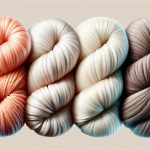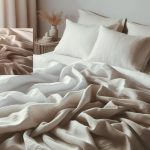You might not realize that some fabrics naturally resist pilling and abrasion better than others. Understanding the characteristics of materials like silk, wool, and hemp can greatly impact your wardrobe’s longevity. These fabrics not only stand the test of time but also contribute to a more sustainable lifestyle. Curious about which options are best for durability and comfort? Let’s explore the world of resilient textiles and their benefits.
Table of Contents
Key Takeaways
- Wool and Silk: Both fabrics are naturally resistant to pilling, maintaining their quality and appearance over time.
- Hemp: Known for its strength, hemp fibers resist fraying and wear, making it durable against abrasion.
- Linen: Its natural strength and tight weave contribute to its resistance to both pilling and abrasion, enhancing longevity.
- Alpaca: This fiber is soft yet durable, providing hypoallergenic properties and resistance to pilling while being abrasion-resistant.
- Cotton with Spandex: This blend combines cotton’s breathability with spandex’s elasticity, offering durability and resistance to wear.
Linen: The Durable Summer Choice
When you think of summer fabrics, linen often stands out as a top choice for its durability and breathability. This natural fiber wicks moisture away from your skin, keeping you cool on those hot, sunny days.
Its unique texture adds a casual, yet elegant look to any outfit, making it versatile for both beach outings and city strolls. Linen’s strong fibers resist wear and tear, ensuring your clothes last through many seasons.
Plus, it becomes softer with each wash, enhancing comfort over time. You’ll appreciate how it resists pilling, maintaining its fresh appearance longer than many other fabrics.
Embracing linen means embracing a stylish, practical option that withstands the rigors of summer adventures while keeping you chic and comfortable.
Silk: Luxurious and Pilling Resistant
When you think of silk, you probably imagine its luxurious feel and smooth texture against your skin.
This fabric not only offers a touch of elegance but is also resistant to pilling, making it a smart choice for those who appreciate quality.
However, it’s important to take into account the environmental impact of silk production as you enjoy its benefits.
Luxurious Feel and Texture
Silk offers a luxurious feel and texture that elevates any fabric experience, making it a preferred choice for those who value both comfort and elegance.
When you run your fingers over silk, you’ll immediately notice its smoothness and softness, creating a sensation that’s hard to replicate with other materials. This delicate touch not only enhances your comfort but also adds an air of sophistication to your wardrobe or home decor.
Unlike many fabrics, silk drapes beautifully, allowing it to create stunning visual effects while maintaining its plush quality.
Whether you’re wearing a silk blouse or lounging on silk sheets, you’ll appreciate the way it feels against your skin.
Embracing silk means indulging in a truly luxurious experience every day.
Environmental Impact Considerations
The luxurious feel of silk not only enhances comfort but also brings an important aspect to reflect upon: its environmental impact. While silk is biodegradable and produced from silkworms, the farming practices can have significant effects on ecosystems. You’ll want to evaluate the sustainability of the silk you choose.
| Aspect | Impact | Considerations |
|---|---|---|
| Production | Resource-intensive | Look for ethical sources |
| Biodegradability | Positive | Compostable over time |
| Pesticides & Chemicals | Negative | Opt for organic silk |
Merino Wool: A Superior Alternative
When you think about durable fabrics, Merino wool stands out as a superior choice.
It not only resists pilling effectively but also offers impressive durability against abrasion.
You’ll appreciate how Merino wool combines comfort with long-lasting performance.
Pilling Resistance Benefits
Choosing fabrics that resist pilling can greatly enhance your wardrobe’s longevity, and Merino wool stands out as a superior option.
By incorporating Merino wool into your clothing collection, you’ll enjoy several benefits that keep your garments looking fresh and new.
- Enhanced Appearance: The smooth texture of Merino wool minimizes pilling, maintaining a polished look.
- Increased Durability: Fabrics that resist pilling tend to last longer, saving you money on replacements.
- Comfortable Wear: Merino wool feels soft against the skin, ensuring you enjoy both style and comfort without the annoyance of pilling.
Abrasion Durability Features
While many fabrics struggle with wear and tear, Merino wool stands out for its impressive abrasion durability. This natural fiber can withstand daily use without losing its integrity, making it a fantastic choice for active wear and outdoor clothing.
You’ll appreciate how Merino wool maintains its shape and softness even after repeated friction. Unlike synthetic fibers, Merino’s structure allows it to recover quickly from compressions, reducing the chances of unsightly pilling and wear marks.
Plus, it’s breathable and moisture-wicking, ensuring you stay comfortable regardless of the activity. When you choose Merino wool, you’re investing in a fabric that not only lasts but also feels great against your skin, giving you confidence in your clothing’s longevity.
Cotton With Spandex: Enhanced Performance
Cotton with spandex blends offer enhanced performance by combining the natural breathability of cotton with the elasticity of spandex. This combination makes the fabric not only comfortable but also durable, reducing pilling and improving its overall lifespan.
You’ll appreciate how these blends move with you, providing flexibility without sacrificing style.
Here are some benefits of cotton with spandex:
- Comfortable Fit: The stretch allows for a snug yet comfortable fit, ideal for active wear.
- Durability: The blend resists wear and tear, making it suitable for everyday use.
- Easy Care: You can often machine wash and dry these fabrics without worrying about shrinkage or distortion.
With cotton and spandex, you get the best of both worlds!
Alpaca: A Lesser-Known Gem
If you’re seeking a fabric that combines luxury with durability, alpaca wool is a lesser-known gem worth exploring. This stunning material stands out with its soft texture and natural sheen, making it perfect for both cozy sweaters and elegant scarves. Plus, alpaca is hypoallergenic, so you can wear it comfortably.
| Feature | Benefits |
|---|---|
| Softness | Gentle on your skin |
| Warmth | Keeps you cozy in winter |
| Lightweight | Easy to wear and carry |
| Eco-friendly | Sustainable and renewable |
Embrace the elegance of alpaca wool, and you won’t just be investing in a fabric; you’ll be choosing a lifestyle of comfort and sophistication. Don’t miss out on this unique choice!
Abrasion Resistance of Natural Fibers
Alpaca wool’s luxurious qualities make it an appealing choice, but when it comes to durability, the abrasion resistance of natural fibers is equally important to assess.
Understanding which natural fibers resist wear and tear can help you make a more informed decision for your textiles. Here are some key points to reflect on:
- Cotton: While generally soft, tightly woven cotton can hold up well against abrasion.
- Hemp: Known for its strength, hemp fibers resist fraying and wear, making it a robust option.
- Linen: This fiber’s natural strength and durability contribute to its longevity, especially when treated properly.
The Role of Fiber Length and Weave Tightness
While you might think that all fibers are created equal, the length of the fibers and the tightness of their weave greatly impact a fabric’s resistance to pilling and abrasion.
Longer fibers tend to create smoother surfaces, reducing friction and the likelihood of pilling. When fibers are longer, they’ve less chance to break and cause those annoying little balls of fuzz.
Similarly, a tightly woven fabric holds the fibers together more securely, preventing them from rubbing against each other and wearing down.
Loose weaves, on the other hand, can lead to increased abrasion, making your fabric more prone to damage.
Care and Maintenance for Reducing Pilling
Understanding how to care for your fabrics can greatly minimize pilling and extend their lifespan.
By following a few simple maintenance tips, you can keep your clothes looking fresh and new.
- Wash with care: Use cold water and a gentle cycle to reduce friction during washing.
- Avoid the dryer: Instead of tossing items in the dryer, air-dry your fabrics to prevent heat damage and pilling.
- Store wisely: Fold your clothes instead of hanging them, as this lessens stress on the fibers.
Evaluating Environmental Sustainability in Fabrics
As you consider the fabrics you choose, it’s essential to evaluate their environmental sustainability.
Look for materials that are sustainably sourced, like organic cotton or hemp, which require fewer chemicals and water. Recycled fabrics, such as polyester made from plastic bottles, can also reduce waste and conserve resources.
Check if the manufacturing processes are eco-friendly; some brands prioritize low-impact dyes and energy-efficient production methods. Certifications like GOTS or OEKO-TEX can signal that a fabric meets environmental standards.
Remember, the longevity of a fabric plays a role, too. Choosing durable materials means less frequent replacements, ultimately benefiting the planet.
Frequently Asked Questions
How Can I Identify High-Quality Natural Fibers?
To identify high-quality natural fibers, check for softness, durability, and a smooth texture. Look for labels indicating fiber type, and feel the fabric; it shouldn’t fray easily or have an overly shiny appearance.
Are There Any Treatments to Enhance Pilling Resistance?
You know how knights once sought armor for protection? Similarly, you can enhance pilling resistance by applying fabric treatments like silicone finishes or using anti-pilling sprays, which help your fabrics stay smoother and last longer.
What Are the Best Washing Practices for Pilling Resistance?
To improve pilling resistance, you should wash garments inside out, use gentle cycles, and select cold water. Avoid overloading the washer, and skip fabric softeners, as they can contribute to pilling over time.
How Does Humidity Affect Fabric Pilling?
Humidity can increase the likelihood of fabric pilling. When moisture is present, fibers swell and loosen, making them more susceptible to friction and pilling. Keeping fabrics dry helps maintain their integrity and reduces pilling risks.
Can Pilling Be Repaired or Removed Effectively?
Did you know about 30% of fabric pilling can be effectively removed with a fabric shaver? You can tackle pilling by gently shaving it off or using a lint roller for quick fixes and smoother fabrics.
- Removing Ink Stains From a Polyester Shirt - June 8, 2025
- How to Get Red Wine Out of a White Carpet - June 8, 2025
- The Ultimate Guide to Choosing Performance Fabrics for Specific Needs - June 8, 2025





